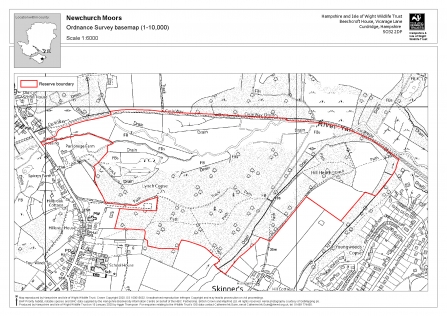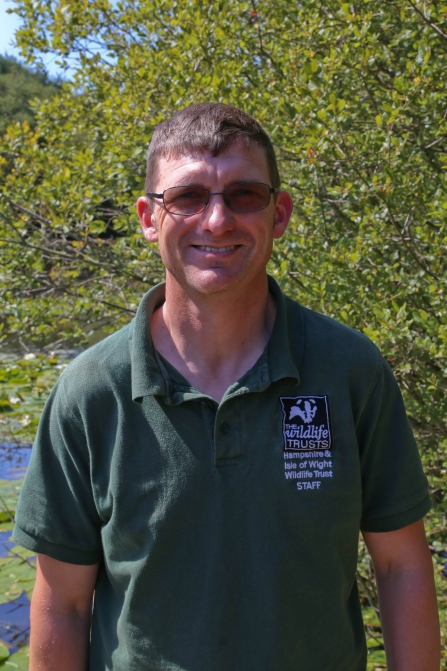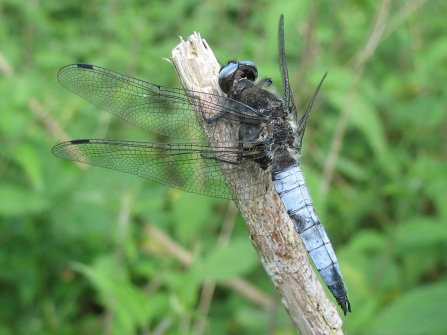
Eastern Yar, Isle of Wight © Ian Pratt
Newchurch Moors – secured for wildlife
Successful appeal to support wildlife
Back in October 2019 we launched an appeal to purchase two very special pieces of land on the Isle of Wight, both with huge potential to help wildlife flourish. Thanks to a kind gift in the Will of Gwendolen Bunce, a local Island resident, we already had a contribution towards the purchase price. We urgently needed to raise £245,000 to complete the purchase and to give us the funds to carry out the necessary management work. We were delighted when we exceeded this target just before Christmas

This 124 acre nature reserve covers the sites of Parsonage Farm, Hill Heath and Martin’s Wood. We renamed it Newchurch Moors to mark a new chapter of this site being managed as a single landscape. Moor is an old English word for swamp and fen, it has been used on the Island to describe this type of habitat right up until the 19th century, so we feel the name acknowledges the historic landscape and the location. The nature reserve sits in the Eastern Yar valley, which is a real focus area for the Trust and we have big ambitions here. The purchase of Parsonage Farm and Hill Heath were vital pieces of the jigsaw which enabled this larger landscape to take shape.

The habitats across the site are woodland, relic wood pasture, grassland, floodplain meadows and fen. There is already plenty of wildlife here, such as barn owl, water vole, dragonflies and orchids, and with careful management we will be looking to improve and diversify each of the habitats, allowing even more wildlife to use the site. This spring Trust staff at the site saw good numbers of dragon flies, orange tip butterflies and also heard cuckoo.
Site update (Summer 2020)
Normally when we start work on a new reserve one of the first things that happens is that our Ecology Team carry out a set of baseline surveys, to help us find out exactly what wildlife is on site and where. This allows the site team to put together a detailed management plan for the nature reserve. Unfortunately, this work has been delayed due to Covid19 lockdown restrictions, meaning the Ecologists could not get out to site, but we hope to start the surveys soon.
We already know the main habitats that exist at this site, because of inspections carried out prior to creating the reserve and we have begun the essential work to start the management. For example, the site team have been putting in stock fencing so that we can begin to graze the site.

Longer term vision
On the lower stretches of the nature reserve we want to encourage a better connection between the river and the floodplain. In the past some of the river channels have been straightened and deepened, which means that water travels quickly across the site and water volume in the river can change rapidly. It also limits the amount of valuable riverbank and other wetland habitats that are available to wildlife. We want the river to take a more natural and leisurely path across the site, improving habitats, potentially reducing the risk of flooding downstream and improving water quality too. We hope to enlist the help of ecosystem engineers with this. We are also working through a feasibility study for the introduction of beavers onto the site. Initial results are promising – keep your eyes peeled for more information!
At the Hill Heath part of the reserve we want to reintroduce grazing to bring it back to a wood pasture habitat – great for a whole range of birds, butterflies and insects.
In Martin’s Wood we will start to introduce coppice regimes and other woodland management to help the woods mature whilst keeping the current beneficial habitats for bees and other insects.

Jamie Marsh © Ian Pratt
"We see a future here where red squirrels leap amongst the branches, dormice nestle in the undergrowth and bats flit across the evening skyline. With an abundance of insects and invertebrates rising from the marshes to feed small birds and mammals, we could be treated to the sight of predators such as buzzards and barn owls.
The stretch of river running through Parsonage Farm could become a real stronghold for water voles and other wetland wildlife once restored to its natural state. And could introducing beavers be one of the solutions? Elsewhere, these ‘river engineers’ are breathing life back into degraded floodplains, and they could do the same on the Island.
This could be the start of a much wilder future for the Island."
Jamie Marsh, Reserves Manager

